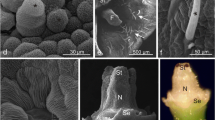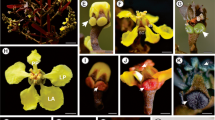Abstract.
The flower of Nelumbo nucifera displays some highly specialized structural details apparently related to its pollination ecology. The functional significance of these structures, however, is still under debate. This paper presents new anatomical and chemical data that contribute to our knowledge of the floral life of the lotus. Special focus is directed on the source of scent and heat production, the role of the staminal appendages, and stigma characteristics. The receptacle, the staminal appendages and connectives are covered with a papillose, osmogenous epithelium and function as osmophores. A fractioned GC-analysis revealed that mainly 1,4-dimethoxybenzene (1,4-DMB) is emitted by these parts, whereas high amounts of C15 – C17-alkanes, n-alkenes, n-alcadienes and n-alkatrienes dominated the volatile blend that was diffusely emitted by the petals. In accordance with the literature, absolute predominance of 1,4-DMB and pentadecane was found, while some differences occurred in minor components. The active source of heat generation, apparently a means to enhance fragrance volatilization, was the receptacle. The compact mesenchyma underlying its upper platform and flanks is glandular and rests on a storage zone replete with starch that becomes exhausted during the metabolic flare-up. Spot measurements confirm the flower’s capacity to maintain a temperature level of ca. 31 °C by compensating the environmental temperature fluctuations. The staminal appendages warm up because they are close to the receptacle; they are not actively thermogenous, as formerly proposed. Their starch load remains nearly unaffected until defloration. The appendages, besides contributing to olfaction, may represent food bodies. Along with the pollen – shed at the male stage of anthesis – the appendages may function as a primary attractant for coleopteran pollinators, an interpretation corroborated by the remaining floral traits, which suggest the cantharophilous syndrome. Published field data, so far only available for the American subspecies, reveal variable mixed assemblages of insect visitors; no feeding on the staminal appendages is recorded. Possibly, the system once involved a partnership that has not persisted during the long history of the genus, which is nowadays attended by opportunists.
Similar content being viewed by others
Author information
Authors and Affiliations
Corresponding author
Additional information
S.V. owes thanks Dr. G. Hausner (Mainz) for providing provisional gas-chromatographical scent analyses. A. Urban operated the freezing microtome, S. Sontag and S. Pamperl kindly assisted in various practical problems. Suggestions given by Prof. Dr. A. Weber and anonymous referees, as well as the stylistic improvement of the manuscript by Dr. M. Stachowitsch are gratefully acknowledged.
Rights and permissions
About this article
Cite this article
Vogel, S., Hadacek, F. Contributions to the functional anatomy and biology of Nelumbo nucifera (Nelumbonaceae) III. An ecological reappraisal of floral organs. Plant Syst. Evol. 249, 173–189 (2004). https://doi.org/10.1007/s00606-004-0203-6
Received:
Accepted:
Published:
Issue Date:
DOI: https://doi.org/10.1007/s00606-004-0203-6




